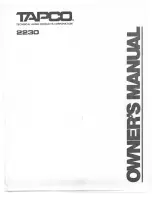
12
ALTAiR
EQ-215/230 GRAPHIC ECUALISERS
TURN ON DELAY CIRCUIT
The ALTAIR graphic equalisers incorporates a delay circuit, consisting of a relay, which
protects the output signal from switch-on transients. This delay takes two seconds, and in the
meantime the equaliser remains in by-pass.
This delay circuit makes also possible that the equaliser remains in by-pass while it is
not switched on, and therefore, in case of breakdown, it is not necessary to take the unit
physically out of the sound system.
This by-pass is mechanical (links the output connector pins to the input connector pins
one by one). For this reason it is necessary to be careful when using distinct input/output
wiring configuration because otherwise the by-pass don't work as expected, and signal
interruption will appear on the signal path.
LEVEL CONTROL
Each graphic equaliser channel (CH-1, CH2) provides a gauged input level
control between -
∞
and +6 dB. This control is placed before the equaliser filters
and therefore, its gain adjustment will affect the headroom of the whole equaliser
circuitry. See Block Diagram for details.
SIGNAL AND OVERLOAD INDICATOR
The graphic equaliser incorporates a multipurpose signal and overload
circuit on both channels. The indicator is a tricolor LED placed at the graphic equal-
iser front panel.
This multipoint level circuit indicates the highest level reached inside the equaliser
circuits and warns the operator about possible problems. When the level indicator lights
green, the internal level has reached -20 dBv.(signal present led). Upon lighting the level
indicator in yellow, the internal level is 0 dBv.(nominal level). Should any internal level is near
overload (+17 dBv) the level indicator lights on red to warn the security limit has been sur-
passed. On that case the equaliser has a 5 dB extra dynamic reserve or headroom.
If the unit is near overload (level indicator in red color), and you want to discover in
which point is taking place, follow the next steps:
Press the BYPASS switch
, if the level indicator remain red, decrease the level
control
up to -
∞
, otherwise continue with the next step. If the overload disap-
pears,
we must place the level control more lower than we have before, be-
cause
the overload was in this control. If the overload persist, it is because it
has a very high input level (more than 18 dBv), because of we must lower the previous unit
in the sound system.
Turn off the parametric filter with the ON/OFF switch (only for EQ-230, for the EQ-
215 continue with the next step.), if the overload disappears, we must place the parametric
filter with a lower gain, by means of the parametric filter gain control.
The overload is placed in the graphic equaliser band-pass filters , because of we
must lower the global level of the band-pass filter to avoid the overload.
1
2
3
Содержание EQ-215
Страница 18: ...18 ALTAiR EQ 215 230 GRAPHIC ECUALISERS...







































